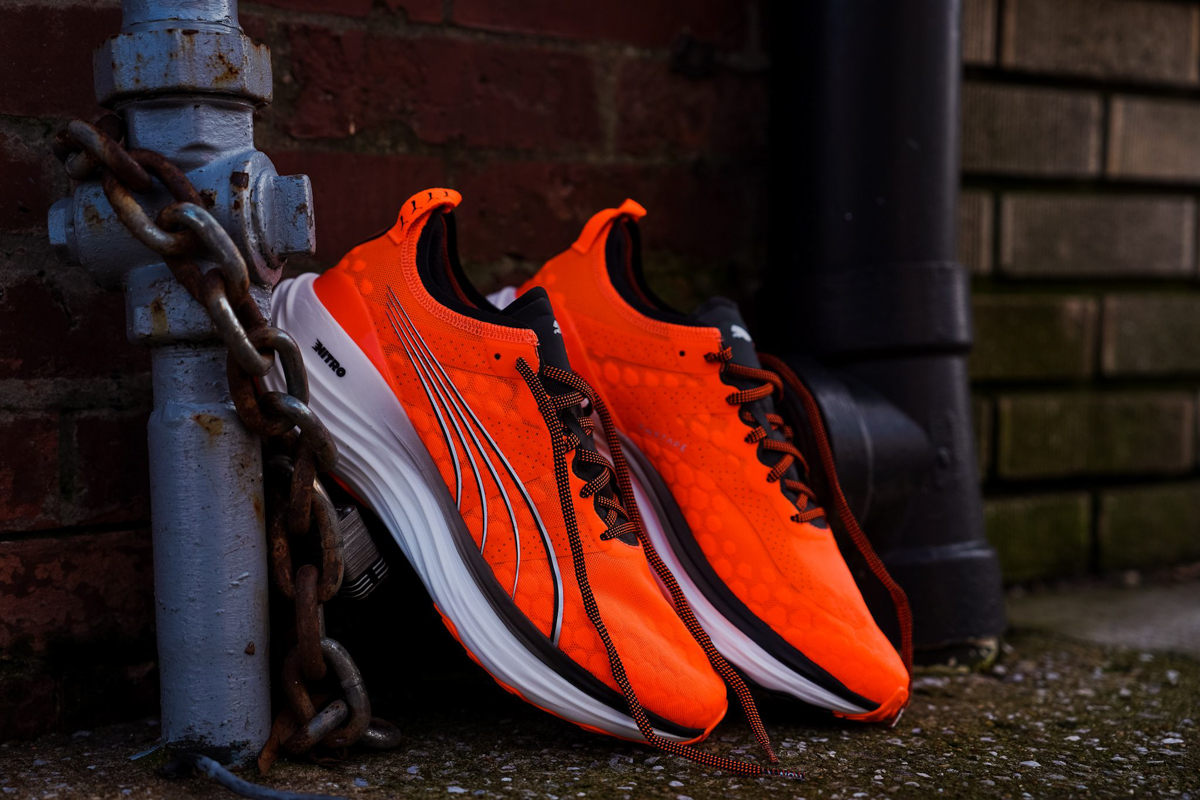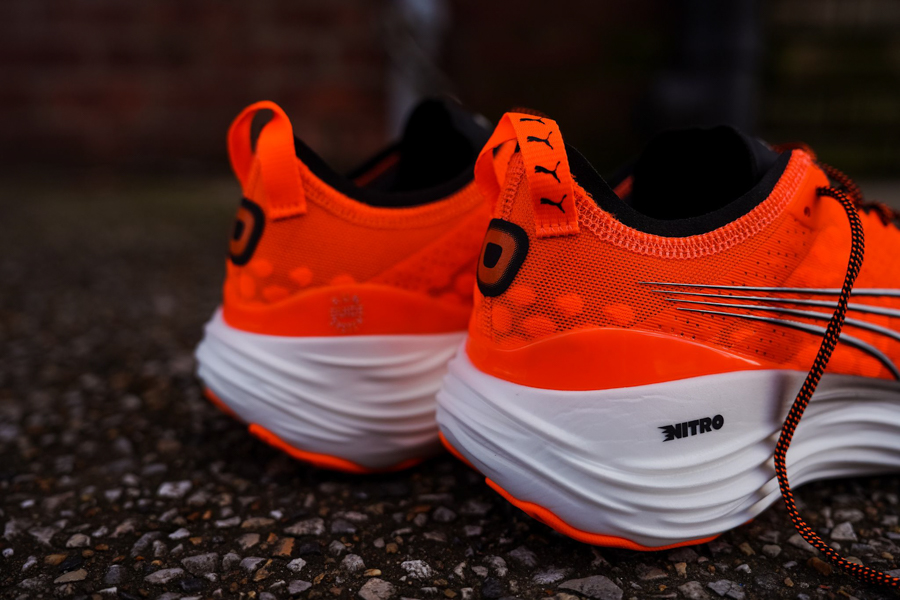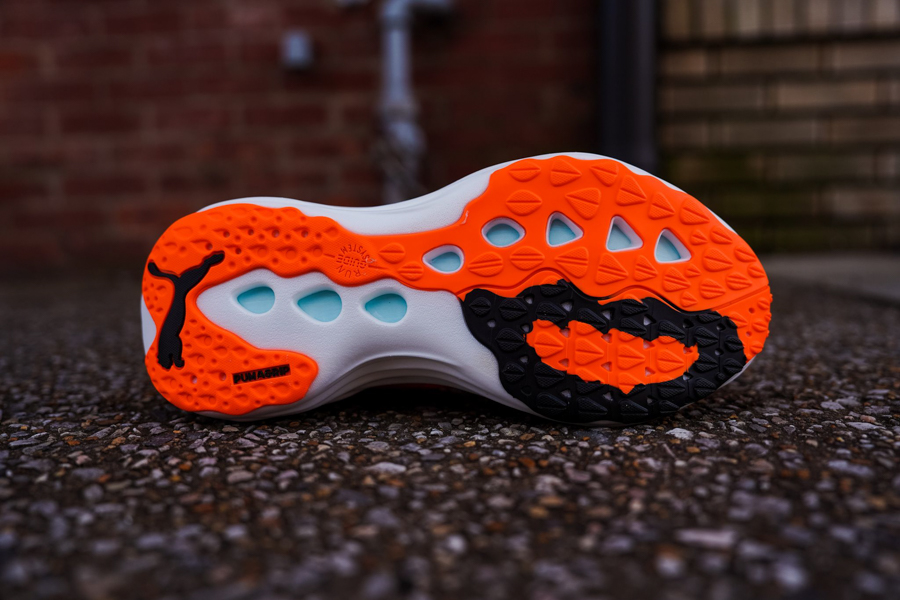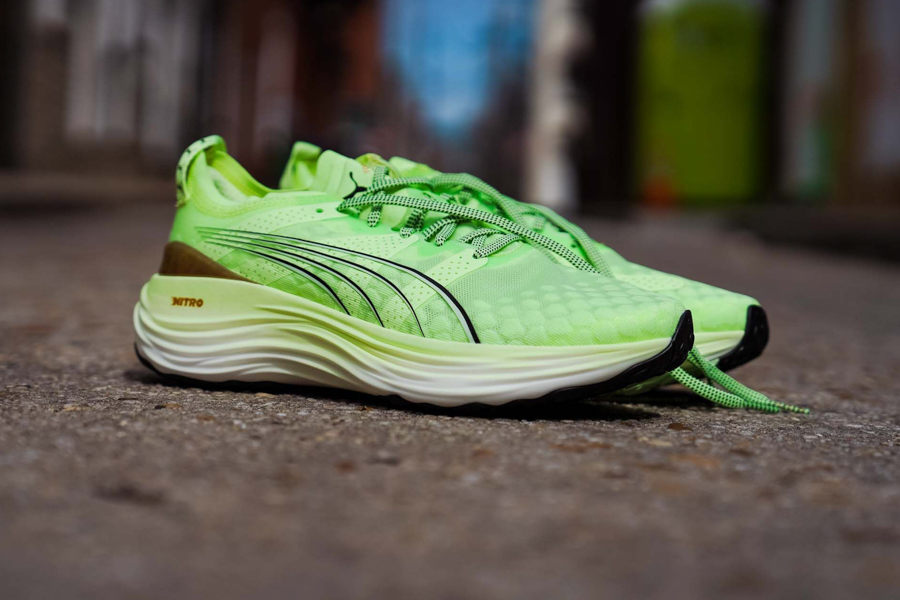
We independently review everything we recommend. When you buy through our links, we may earn a commission.
9.6 oz. (272 g) for a US M9,
8.3 oz. (235 g) for a US W8
36 mm in heel, 26 mm in forefoot (10 mm drop)
Stability miles with a flash of style
Dual-layer Nitro midsole, PWRTAPE structure, breathable mesh upper
$150
THOMAS: We get a lot of boxes full of shoes and gear through our doors, some more exciting than others. For example, up until last year, opening a box and finding a pair of stability shoes usually measured a four out of ten on the excite-o-meter. I mean, who doesn’t want to strap heavy trainers with hard medial posts to their feet in order to get enough miles for a proper review? Alright, except for Aldren. The rest of us would suffer through the experience purely for the benefit of the readers and then head straight for the donation pile.
Those times are behind us. Some brands have pivoted from stability shoes into what they’re calling guidance shoes. Gone are the hard medial posts and the plastic heel counters that felt more like braces than running shoes. Puma is the latest brand to jump into the party that Hoka, Asics, and Saucony already have rocking. Saucony blew us away with the Tempus, which currently sets our stability standard. It was stable but fun, combining lightweight foams with an upper that feels as good as it looks, but could Puma keep pace?
If you need guidance, all that matters is you no longer have to wear orthopedic monstrosities on your feet. Now, we just have to find out how the Puma ForeverRun Nitro stacks up.
MEAGHAN: As Thomas noted, it’s never exciting when a stability shoe shows up for review. That said, the ForeverRun Nitro was an unexpected treat, in the sense that I didn’t know it was actually coming and also that it didn’t feel like a traditional stability shoe.
Puma’s innovative support and guidance, as they put it, is built into this shoe via a two-piece Nitro midsole — a firmer rim with a softer core and Puma’s clever Runguide System, which includes supportive details like the PWRTAPE, a heel clip, and a specially designed orthotic insole.
There’s a solid 36mm of foam underfoot, 26mm in the forefoot for a 10mm drop, and my US W7.5 came in at 8.3 oz.
Do we finally have stability without the suck?

THOMAS: Puma’s technical mesh upper is reinforced with its PWRTAPE, which gets layered and welded to create a structure that doesn’t look or feel overbearing. The ForeverRun Nitro has a gusseted elastic tongue that fits securely as you tighten it down. We’ve had issues with Puma’s heel lock in the past, but the ForeverRun Nitro has plenty of padding back there, which kept us locked in place. There’s a soft rubber-like heel clip, too, which adds even greater stability. Despite all of the tech, the mesh is comfortable, breathable, and fits true to size.
Let’s move on down to the midsole. Puma’s Nitro foam is excellent for daily trainers. It’s soft and bouncy but certainly not heavy. As long as we are talking about weight, the ForeverRun Nitro weighs 10.5 oz. (297 g) for my US M10.5. Anyway, back to the midsole. The ForeverRun Nitro uses a rim and core build to add stability without a proper post. It mixes a softer inner foam in the core for plush landings and step-in comfort, while firmer Nitro foam serves as an outer shell for the stability factor. It’s tougher than the inner foam, so it shouldn’t break down on you, and the wide base makes for easy landings.
Puma’s one-two punch makes the ForeverRun Nitro feel much more stable than a truly neutral shoe. The outsole rubber plays a role, too, thanks to a thick “J” panel that follows the midsole’s careful geometry.
Honestly, running in the ForeverRun Nitro feels so unobstructed that you might forget that it’s a guidance trainer. It feels as nice to run in as a neutral trainer, with plenty of cushion and a lively pop.

MEAGHAN: I left the ForeverRun Nitro sitting in its box for a few days before Thomas finally got me to lace it up. I’m not sure why I waited. The step-in feel was shocking. It felt, dare I say it, plush. Puma’s Nitro foam is both soft and responsive, and the upper hugs the foot just right. I found the shoe fits true to size, even with my wider foot. Although there’s probably more padding around the collar and tongue than a typical trainer, it’s not overbearing. The upper itself has a bit of an odd pattern but is still light and breathable.
Out on the run, the ForeverRun Nitro felt great as well. The gusseted tongue and lacing system do a great job keeping the foot locked down, and the midsole is plenty bouncy. I wouldn’t guess this shoe was designed for someone needing support and guidance — it truly felt like a neutral daily trainer.
Shop Puma ForeverRun Nitro - Men Shop Puma ForeverRun Nitro - Women
THOMAS: This happens a lot when I use hot sauce. I gradually add more and more, just a dash at a time. Before I know it, I’m eating hot sauce with a side of food. That’s what happened with the ForeverRun Nitro’s outsole rubber. It feels thick and definitely hampers some of the flexibility — though that might be by design.
MEAGHAN: The Puma ForeverRun Nitro felt a little slappy out on the road. I’m not sure if it’s the rubber outsole or firmer Nitro rim, but it wasn’t the smoothest running trainer.
Also, I’m just assuming the stability features actually work for someone who needs it. As a neutral runner, I do not.
Shop Puma ForeverRun Nitro - Men Shop Puma ForeverRun Nitro - Women
THOMAS: Puma did it! The ForeverRun Nitro is a legitimate pick for a light stability/guidance trainer. I’d put it right up there with the Saucony Tempus, Asics Kayano, and Hoka Arahi. Pronators, rejoice. You finally have another option to add to your ever-growing rotation. Even as a neutral runner, I enjoyed my miles in the Puma ForeverRun Nitro. I hope you will, too, should you decide to pick up a pair.
MEAGHAN: I agree with Thomas, Puma has a great offering with the ForeverRun Nitro. It’s comfortable, bouncy, and a great addition to the stability category. You can snag a pair for $150.
You can pick up the Puma ForeverRun Nitro for $150 at Running Warehouse (featuring free 2-day shipping and 90-day returns) by using the buttons below.
Want to learn more about how our review process works? Check out this guide.

Have something to say? Leave a Comment

As the founder of Believe in the Run, Thomas’s goal is to help runners pick the shoes and gear that will make their running experience the best that it can be.
More from Thomas
Meaghan signed up for her first marathon three weeks before the race, because it was $10 more than the half she planned to run. She learned everything in running the hard way. Now a USATF & UESCA certified run coach, she loves encouraging friends to go for big goals as she continues to chase faster times. She enjoys a hot cup of coffee, a cold martini, and making bagels for friends and family.
More from Meaghan
I know the price point lands right there with a lot of the comparable shoes (Brooks Adrenaline, Saucony Guide, etc) but I always question why these brands with virtually no market share price their shoes like this. Like, why, as a consumer, would I pick these up over either of those other two shoes which are well-established and consistent and I know what I’m getting? I’d have to think if you priced it cheaper, you’d at least be able to make some in-roads. As it is, it’s hard enough to get on the “shoe wall” at the running specialty stores.
Maybe I’ll try them when they are reduced to $100 or less in 6 months on RunningWarehouse
I love reading the articles and watching BITR’s youtube videos. Your reviews are usually spot-on and very humorous. Thanks for that 🙂 However I have one point to make. The pictures in these written reviews are usually a little overprocessed – darkened and saturated. It makes the shoes look pretty sometimes, but it doesn’t depict the actual color of the shoes. It has happened with me a couple of times where I tried to find the color on the manufacturer’s website, just to realize that the actual color was way too dull 🙁 This is just my observation. Please feel free to ignore my comment if you wish. I just thought I’d let you know anyway. Wish BITR all the very best. Cheers!
Seems like a review that should have been done by someone who uses stability shoes like Aldren… Hearing “it’s probably good for a stability shoe but I don’t need that” and having it compared to all of these other awesome neutral shoes that we can’t really wear anyway isn’t super helpful.
The most informative part is when you say that it “doesn’t feel like a stability shoe” and that’s a nice compliment, but it doesn’t answer the question of whether or not it actually functions as a stability shoe. Spoiler, it does.
The fact that you compared it to the arahi says you haven’t had to deal with running in an arahi. The arahi admittedly has more stability but it’s so godawful to run in. Zero energy return AND it’s somehow also too hard. It’s like wearing a sandbag on my heels.
But I think what this review needed was less “It’s good for a stability shoe” and more excitement from someone who has been chained to arahis and guide 16’s or dealing with the tempus toeliner failures strapping on a shoe that feels FAST, BOUNCY, NIMBLE, COMFORTABLE, and most of all: it just feels FUN. It’s a fun shoe that makes me want to go for a run. It makes me want to run faster and farther.
I could not agree more.
You don’t do a MERCEDES E class combi review and finish it with ” But since I’m single I drive a BMW Z4, so I don’t really need all that space, famously comfortable back seats or trunk specials anyway.
Drivves ok for a car with so much clutter though….”
I do hope you get what we mean, and that we don’t mean to be mean, but for you to test following the mean and not the upper or lower extremes.
Meaning my meaning is truly meant to help.
(and Sound a bit fun^^).